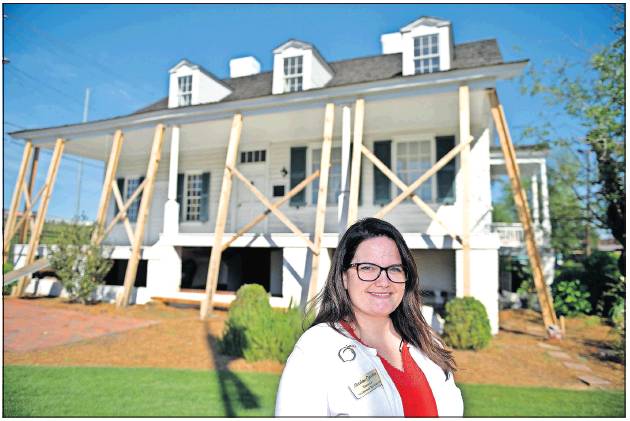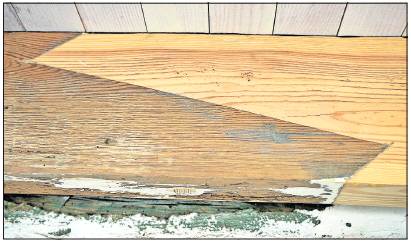Fresh look at history
New director watching over renovations at home of Declaration of Independence signer
By Susan McCord Staff Writer
Augusta’s oldest documented house is getting a fresh face and a millennial perspective.
After all, George Walton was only 26 when he signed the Declaration of Independence.
Now in charge of Meadow Garden, Walton’s home from its construction in 1791 through the final 15 years of his life, is director Stephani Roohani. Leading a group of eight on a tour Tuesday, Roohani noted the “Smurf blue” front room has been repainted its original Stratford blue, a greenish tint, after a paint analysis.
She wound the 1800 grandfather clock, her “favorite piece” at the home, making it chime. The clock works but doesn’t keep perfect time.
“When you’re as old as this clock, I think that’s OK,” said Roohani, 35.
The Army veteran with 11 years of active duty was recently named the Georgia Daughters of the American Revolution’s “outstanding junior.” The state chapter owns the home, which has been a house museum since 1901 and is the oldest house museum in the state.
Roohani said she might not be who most imagine when they think of the Daughters of the American Revolution, but that’s OK.
“I’ve always been interested in my own family genealogy, since I was a little girl,” she said. “About 10 years ago, I found my patriot ancestor. His name is Cornelius Treat and he served in the Massachusetts army during the Revolutionary War.”
Coming to the area to work at Fort Gordon, Roohani connected with the College Hill chapter of the Daughters of the American Revolution and spent years becoming familiar with Meadow Garden. She was leaving her Department of Defense job to return to school when the opportunity to manage Meadow Garden arose.
Lately, the atmosphere at Meadow Garden is one of change, driven by an extensive preservation master plan funded through a large donation, Roohani said. The Savannah firm Landmark Preservation scrutinized every detail of the house, including prior renovations, to create the plan.
“It lays out the plan for what we can do to restore it to the way it should look, and for proper maintenance of the home so it’s around for future generations,” she said.
Approaching completion is restoration of the Sand Hills cottage-style home’s porch. Some of its hand-hewn beams are being preserved, and Landmark Preservation has used mainly “hammer and chisel” and the period method of mortise and tenon joints to join the boards, Roohani said.
In the plan is restoration of a prominent detail that Walton might have never seen. Old photographs and renderings show an uneven roof line across the front, resulting from the addition of rooms beside the original home with a higher roof line. At some point , the roof was leveled.
“Eventually, they’re going to adjust that roof line – it’s really going to show the difference,” Roohani said.
The home was originally situated on around 150 acres away from Augusta’s center. Though Walton did not own slaves, his wife inherited some and they likely resided on the property in one of several additional structures that no longer exist, she said.
The house is decorated with period furniture, most donated by Harriet Gould Jeffries, the Daughters of the American Revolution member who founded and led the effort to open the house in 1901. Many relics of George Washington – long said to have stayed at the home, although that is unproven – decorate the home, she said.
The 10-year master plan for restoration will likely take longer, and will depend largely on available funding and urgent needs that a 228-year-old home may encounter, Roohani said.
“It’s flexible in that if there’s a need that comes up before something else, we can shift and manage that and take care of the necessary work,” she said.
Roohani credits the creation of social media accounts with a more than 50 percent uptick in visits since 2017. About 556 additional people toured the home last year, up from 957 the year before.
Walton was the youngest signer of the declaration from Georgia, but can’t claim the youngest overall because the precise date of his birth in late 1749 is not known, Roohani said. The ambitious orphan was raised by an uncle and, as a young attorney, had to swear his allegiance to the British Crown.
It was as if to say, “Hey King George, I’ve got your back – and we all know what happens next,” Roohani said.
Active in Georgia’s patriot movement, Walton was elected to the Georgia provincial congress and later the Continental Congress, where he signed the Declaration of Independence at an age when some millennials are just moving out of their parents’ homes.
“It’s pretty incredible to think that at 26 years old that is what he is doing with his life,” she said.
Walton twice served as Georgia governor, and was a U.S. senator, a judge and chief justice of the Georgia Supreme Court. He died in 1804, a few months after his son, Thomas, died at age 21. George Walton Jr. moved to Florida, where he became the namesake of places such as Fort Walton Beach, Roohani said.
Walton and fellow Georgia signer Lyman Hall are buried under Augusta’s Signers Monument downtown. The third Georgia signer, Button Gwinnett, was interred in Savannah, though the location of his grave is unknown.
Mike Priebe of North Augusta, touring the home for a second time, snapped a picture of one of his favorite relics – fireplace andirons in the likeness of George Washington. The house is a great but sometimes overlooked place to take visitors, he said.
“These cool artifacts – this is the part of history you don’t hear in school,” he said. “We live in the area and sometimes never know to take advantage of these amazing historical places."

